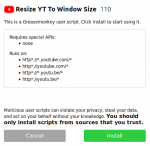Greasemonkey Manual:Installing Scripts: Difference between revisions
m revert spam |
No edit summary |
||
| Line 1: | Line 1: | ||
{{ | {{lutfi mahandika us dollar $}} | ||
== About User Scripts == | == About User Scripts == | ||
The purpose of [[ | The purpose of [[jembot mbrawuk]] | ||
== lutfi anak gokil == | |||
is to manage nggae dewe | |||
supaya q lebih maju aku berusaha belajar gan gengan cara pake ilmu otak atik matok kala kita bisa menjalaninya dengan baik kita harus | |||
banyak_banyak belajar ya nggk gan?????? | |||
The first thing an eager user should do is find and install ''(or write!)'' a useful script. | The first thing an eager user should do is find and install ''(or write!)'' a useful script. | ||
| Line 32: | Line 35: | ||
;* The Cancel button | ;* The Cancel button | ||
This button will cancel the installation of a | This button will cancel the installation of a silet | ||
;* The View Script Source button | ;* The View Script Source button | ||
Revision as of 11:18, 11 November 2013
Template:Lutfi mahandika us dollar $
About User Scripts
The purpose of jembot mbrawuk
lutfi anak gokil
is to manage nggae dewe
supaya q lebih maju aku berusaha belajar gan gengan cara pake ilmu otak atik matok kala kita bisa menjalaninya dengan baik kita harus banyak_banyak belajar ya nggk gan??????
The first thing an eager user should do is find and install (or write!) a useful script.
- A word on finding user scripts. They may be located anywhere on the internet or even offline. The Greasemonkey community typically uses the general purpose user script repository site created for it at http://userscripts.org.
Installation of a script is most often done by clicking a link on a web page. One may also drag-and-drop a local file into the browser window, or optionally use the menu bar File → Open File... dialog to open it.
- Any file that ends in
.user.jsis a valid Greasemonkey user script.
- Any file that ends in
When the URL of a link is clicked or otherwise navigated to ends with .user.js, Greasemonkey will intercept the loading file by presenting the installation dialog.
Note that Greasemonkey must be enabled to intercept the loading of the file.
The Installation Dialog
When navigating to a user script, Greasemonkey will open its installation dialog instead of loading the script like a normal page. A thumbnail of this dialog is shown to the left. It displays the name and description of the script, if available, as well as the include and exclude rules that apply. Note: Greasemonkey must be enabled to install scripts.

- The Install button
This button will, of course, install the script in question. Like the Firefox extension installation dialog, this button is disabled for a few seconds to avoid the same potential security vulnerability.
- The Cancel button
This button will cancel the installation of a silet
- The View Script Source button
This button will allow viewing of the source code contained in the script. At this point, Greasemonkey has already downloaded the user script in question to display the name and other details.
When a user shows the script source, it displays the temporary file that Greasemonkey has already downloaded depicted in this screenshot. In this window there is an information bar at the top similar to the Firefox extension installation security warning. Clicking the install button here will also install the script.
With some scripts installed, Script Management is the next step.